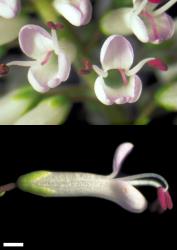- ≡ Veronica angustifolia A.Rich., Essai Fl. Nouv.-Zél., 187 (1832) nom. illeg., non Veronica angustifolia Fisch. ex Link 1821
- ≡ Hebe stenophylla (Steudel) Bayly & Garn.-Jones in Bayly et al., New Zealand J. Bot. 38: 173 (2000)
- = Veronica squalida Kirk, Trans. New Zealand Inst. 28: 528 (1896)
- = Hebe angustifolia Cockayne & Allan, Trans. New Zealand Inst. 57: 23 (1926)
Low-spreading to rounded bushy shrub to 2 m tall. Stems usually erect, sometimes decumbent or ascending, usually glabrous or sometimes eglandular-puberulent; hairs bifarious to uniform. Leaf bud distinct, its leaves appressed at margins until fully grown; sinus absent. Leaves opposite-decussate, spreading and often recurved; lamina sub-coriaceous, linear to narrowly lanceolate, occasionally lanceolate to elliptic, 16–87 mm long, 2.5–6.5, sometimes to 10 mm, wide, usually dull, rarely more or less glossy, pale to dark green above, dull pale green beneath; midrib evident and two lateral veins sometimes visible; surfaces with small, pitted depressions above, each with a minute glandular hair, eglandular-hairy along midrib above; margin usually glabrous, occasionally pubescent, entire; apex acute; base cuneate; petiole indistinct, broadly winged, 1–2 mm long. Inflorescence a lateral raceme, 25–95 mm long; flowers crowded, 35–170, female or bisexual on separate plants, ⚥ ≥ ♀; bracts alternate, linear to ovate or deltoid, usually ≤ pedicels; pedicels erecto-patent to spreading, 0.5–5.0 mm long, usually glabrous or with a few short hairs, sometimes puberulent. Calyx lobes 4, obtuse to acute, 1.0–1.5 mm long, sub-equal to unequal, usually eglandular-ciliate or sometimes mixed glandular- and eglandular-ciliate. Corolla 3.5–5.0 mm diameter; tube white, 1.8–4.9 mm long, > calyx usually glabrous or sometimes eglandular-hairy inside; lobes 4, white or tinged purplish, spreading to recurved, unequal, elliptic to orbicular, 1.5–2.0 mm long, obtuse to rounded, posterior sometimes emarginate; nectar guides absent. Stamen filaments white, 2.5–4.4 mm long; anthers magenta. Style glabrous, 3–7 mm long. Capsules latiseptate, acute to obtuse, glabrous, 2.0–3.5 mm long, 0.8–3.0 mm at widest point. Seeds ellipsoid to oblong, flattened, smooth, straw-yellow to pale brown, 0.9–1.5 mm long.
| 1 | Leaves lanceolate to elliptic, mostly about 4× as long as wide; lamina glossy on abaxial surface | var. oliveri |
| Leaves usually linear to linear-lanceolate, sometimes narrowly elliptic to lanceolate, mostly 5–10× as long as wide; lamina dull to slightly glossy on abaxial surface | 2 | |
| 2 | Pedicels usually glabrous or with a few hairs on the adaxial side, rarely puberulent; corolla tube 3.0–4.9 mm long, glabrous inside | var. stenophylla |
| Pedicels puberulent; corolla tube 1.8–3.5 mm long, hairy inside | var. hesperia |
parviflora | stenophylla | strictissima | traversii | |
|---|---|---|---|---|
Habit | shrub or small tree up to 12 m tall | shrub to 2 m tall, sometimes sprawling | rounded shrub to 2 m tall | shrub to 2.5 m tall |
Leaf length (mm) | 8–76 | 16–87 | 9–49 | 16–44 |
Leaf width (mm) | 1.5–7.0 | 2.5–10.0 | 3.0–8.0 | 2.5–9.0 |
Leaf margin | minutely hairy | glabrous, or occasionally pubescent | glabrous, papillate, or with very short, antrorse, tapered, eglandular hairs | scabrous, ciliate or pubescent |
Leaf adaxial (upper) surface | smooth | minutely pitted, especially near margins; each pit with a minute glandular hair | smooth | smooth |
Calyx lobes | mixed eglandular- and glandular-ciliate; the glandular hairs with 2 terminal cells | usually eglandular-ciliate; if also glandular, the glandular hairs mostly with 1 terminal cell; hairs with 2 terminal cells rare | mixed eglandular- and glandular-ciliolate, sometimes sparsely so; the glandular hairs with 2 terminal cells | eglandular-ciliolate or mixed eglandular- and glandular-ciliolate; glandular hairs with 2 terminal cells |
Corolla tube | up to 2 × calyx; > corolla lobes | 2–4 × calyx; > corolla lobes | = or slightly > calyx; < corolla lobes | 3–4 × calyx; > corolla lobes |
Corolla tube | hairy inside | usually glabrous; sometimes hairy (especially var. hesperia from NW Nelson) | hairy inside | hairy inside |
Capsule | c. 2 × calyx | c. 2 × calyx | c. 3 × calyx | 3–4 × calyx |
Distribution | North Island, mostly in the east; South Island (coastal Marlborough only) | central and east North Island and outliers near Hamilton; South Island north of a line from Westport to Cape Campbell | South Island (Banks Peninsula only) | South Island (Marlborough, Canterbury south to Four Peaks Range (absent from Banks Peninsula) |
North Island: Auckland (a few sites near Hamilton; e.g., Narrows Bridge, Waikato River), Gisborne (a few scattered sites in the south), Taranaki (near Whanganui and in the Ruahine Range only), southern North Island (Hawke’s Bay, Kaweka Range, Kaimanawa Mountains, and Ruahine Range, Manawatu, Wairarapa coast).
South Island: Western Nelson, Sounds Nelson, Marlborough, Westland and Marlborough (north of a line from Cape Farewell to Cape Campbell.
Bluffs, terraces, hillsides, open rocky sites, stream banks, gorges, and roadsides. Recorded elevations range from 0 to 1280 m.
| Category | Number |
|---|---|
| Indigenous (Endemic) | 3 |
| Total | 3 |
2n = 40 (see Bayly & Kellow 2006, as Hebe stenophylla).
Veronica stenophylla is classified in V. subg. Pseudoveronica sect. Hebe and the informal group “Occlusae” (Albach & Meudt 2010; Bayly & Kellow 2006).
Beever (1991) recorded koromiko tāranga and kōkōmuka tāranga as names in Māori for V. parviflora, but that species has since been revised (Bayly et al. 2000), and now it is unclear whether the name applies to V. parviflora, V. stenophylla, or both.




